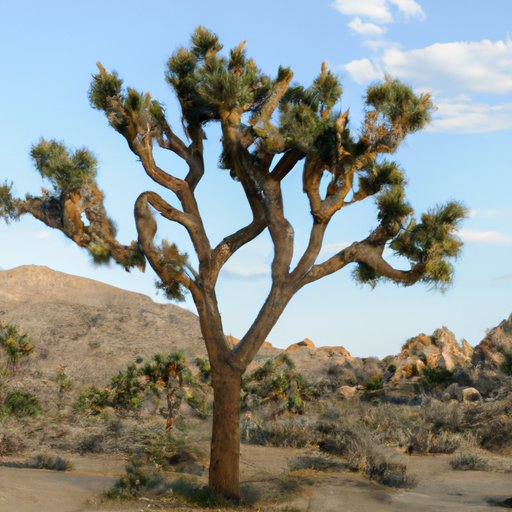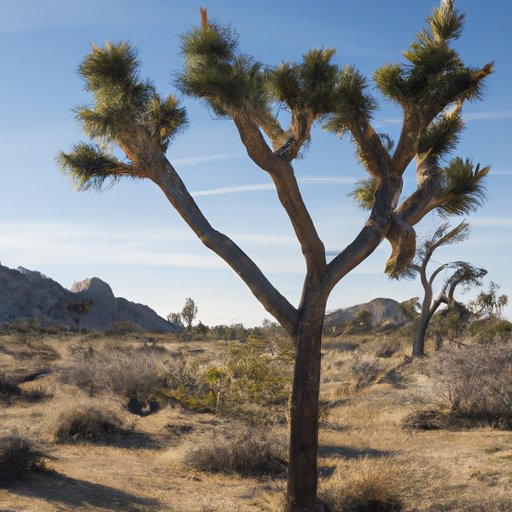Introduction
The Joshua Tree, scientifically known as Yucca brevifolia, is a unique and iconic desert plant found primarily in the southwestern United States. These distinctive trees are known for their spiky, upward-reaching branches and clumps of spiny leaves at their bases. The Joshua Tree is not only important to the ecosystem, but it also has significant historical and cultural significance.
A guide to the iconic Joshua Tree: Everything you need to know about this stunning desert plant
Physical characteristics of the Joshua Tree
The Joshua Tree can reach up to 40 feet in height and has a lifespan of up to 500 years. Its branches are often twisted and bent due to the harsh winds of the desert climate. Joshua Trees are unique in that they only grow in a specific range of elevation ranging from 1,300 to 5,900 feet. Their rough, textured bark serves as a protective layer against the desert heat, and they sprout white or greenish-yellow flowers that bloom in early spring.
Where you can find Joshua Trees
The Joshua Tree is native to the Mojave Desert and can be found in parts of California, Nevada, Utah, and Arizona. They are most commonly found in Joshua Tree National Park, which covers over 790,000 acres of the Mojave Desert and the Colorado Desert. However, Joshua Trees can also be spotted in other areas of the Mojave Desert, such as the Antelope Valley in California.
The best time to see Joshua Trees
The best time to see Joshua Trees is during their spring bloom. The exact timing of their bloom depends on things such as elevation and temperature variations, but generally blooms occur in late February through March. The mild climate of the fall and winter seasons also make for comfortable outdoor recreation activities.
The History and Cultural Significance of the Joshua Tree
Native American legends surrounding the Joshua Tree
The Joshua Tree has deep roots in Native American folklore. According to the legend, the tree’s upturned branches resemble a figure raising its arms towards the sky in prayer. The Cahuilla Indians, a tribal group native to Southern California, believed the Joshua Tree had mystical powers and that its branches provided protection. Additionally, some indigenous tribes used the leaves and fibers of the tree for practical purposes such as baskets and clothing fiber.
The name “Joshua Tree”
The true origins of the Joshua Tree’s name are unclear. It is said that early Mormon settlers named the tree because its rough, angular branches reminded them of the biblical figure Joshua, who was often depicted holding his arms up toward the sky in prayer. However, some people believe that the name came from a Spanish translation mishap. The Spanish may have misheard the Mormon settlers calling the trees “Josué,” which means Joshua in Spanish, as “Joshua.”
Joshua Tree’s role in contemporary culture
The Joshua Tree has been a prominent symbol in popular culture for decades. In fact, the Joshua Tree is celebrated in the 1987 album by U2, which was named after the tree. In recent years, the Joshua Tree has also become somewhat of a cultural phenomenon, with fashion, music, and art trends featuring the plant prominently.
How the Joshua Tree Endures and Thrives in the Harsh Desert Climate
The adaptations of the Joshua Tree to desert climate
The Joshua Tree has adapted to the harsh desert conditions in a variety of ways. Their deep root system allows them to access water well below the desert’s surface, and they often grow in clusters to conserve water. Additionally, the tree’s thick, waxy leaves help to prevent water loss through transpiration and reduce the amount of water required from a specific area. Finally, the fibrous bark of the tree helps to protect it from animals that may graze on its limbs, and the bark helps to insulate the tree from extreme temperature fluctuations.
Joshua Tree’s symbiotic relationship with wildlife
The Joshua Tree also plays an essential role in providing a habitat and food source for wildlife in the desert. The tree’s flowers provide nectar for a wide variety of insects and birds, while the tree’s fruit provides a food source for everything from jackrabbits to bighorn sheep. Additionally, because Joshua Trees grow in clusters, they provide shelter and hiding places for small animals and insects, helping to support endangered species like desert tortoises and kit foxes.
The Ecology of the Joshua Tree: Importance in Desert Ecosystems
The role of the Joshua Tree in ecosystem services
The Joshua Tree plays an essential role in the ecosystem of the Mojave Desert. They are known as keystone species, meaning that they are critical to the desert’s ecology, and their loss can have profound impacts on other species in the area. The tree provides a home for a variety of organisms, including birds, lizards, and rodents. Additionally, its leaves and branches provide a source of insulation and shade for many species, protecting them from the sun and helping to conserve moisture in the desert landscape.
The impact of Joshua Tree’s decline
The health and viability of Joshua Trees are currently being threatened by climate change, urbanization, and increased tourism in the area. Joshua Trees are not likely to be able to adapt quickly enough to survive the extreme heat, drought, and wildfires that are becoming more common in the desert. Additionally, urbanization and tourism can disturb their habitats and reduce the available resources for survival. If Joshua Trees decline or disappear from the Mojave, it can have profound impacts on the ecosystem’s health and cause ripple effects throughout the entire area.
Discovering the Beauty of Joshua Tree National Park
The park’s history
Joshua Tree National Park became an official national park in 1994 and was created to protect the Joshua Tree and other native species of the Mojave and Colorado Deserts. The park’s history dates back to the early 1900s, when miner and cattle ranchers used the land for their own purposes. The park now welcomes over one million visitors annually who come to explore its unique geologic and Palm Oasis landscapes and wilderness.
Popular attractions at Joshua Tree National Park
Joshua Tree National Park is a great place to experience the beauty and majesty of the desert landscape. Popular activities at the park include hiking, rock climbing, and stargazing in one of the darkest skies in California. Additionally, the park offers various ranger-led activities, including tours, educational programs, and star parties.
Activities visitors can do in the park
There is no shortage of activities and sights to see in Joshua Tree National Park. Hikers can explore over 800 miles of trails that range from beginner-level nature walks to strenuous climbs up the park’s highest peaks. The park is famous for its spectacular rock formations, which attract climbers from around the world. Visitors can also take scenic drives through the park, visit historic sites like the Keys Ranch, and experience the dark skies through the many stargazing opportunities at the park.
Joshua Tree: From Folklore to Fame
The prominence of the Joshua Tree in popular culture
The Joshua Tree has long been a popular symbol in the entertainment industry. Not only has it been referenced in music, art, and fashion trends, but even TV shows, movies, and video games use the tree and its surroundings as a backdrop or setting for scenes.
The creation of the Joshua Tree National Park
The creation of Joshua Tree National Park was a concerted effort to protect the Joshua Tree and its ecosystem. The park’s creation was also a response to increasing threats to the desert’s health, such as pollution and rapid development. The park became a sanctuary where visitors could enjoy the beauty of the desert while ensuring that its unique environment remains undisturbed.
The impact of tourism on Joshua Tree
Tourism is a double-edged sword when it comes to the Joshua Tree. Increased tourism can be beneficial for the local economy and raise awareness about the importance of preserving the desert landscape. However, it can also lead to overcrowding, traffic congestion, and depletion of resources vital to the ecosystem. Therefore, it’s essential for visitors to be responsible and respectful during their time at the park.

Preserving the Joshua Tree and Its Habitat: The Threat of Climate Change
The impact of climate change on Joshua Tree
Climate change is one of the biggest threats to the Joshua Tree. The tree’s adaptation to specific conditions makes it vulnerable to any changes in the environment. Global warming and drought can induce wildfires, increase the frequency of heatwaves, and promote invasions of non-native species. These phenomena can have devastating results on the tree and its habitat.
Efforts and policies to protect the Joshua Tree and its habitat
Various organizations are working to protect Joshua Trees and the surrounding ecosystem. In 2020, the Department of the Interior decided to label the Joshua Tree as a candidate for listing under the Endangered Species Act. Other conservation groups are advocating for more sustainable development policies, increasing awareness about the effects of climate change, and supporting measures to reduce carbon emissions. The legal protections aim to reduce the decline of the Joshua Tree and ensure that the species remains a vital part of the Mojave ecosystem.
What people can do to help
Individuals can also take steps to help preserve the Joshua Tree. One of the most effective ways to protect the tree is by reducing carbon emissions in daily life. This means using public transportation or driving less frequently, consuming less meat, using energy-efficient appliances, and investing in renewable energy. Additionally, visitors to Joshua Tree National Park should follow the Leave No Trace principles to ensure that they leave the wilderness undisturbed for future generations to enjoy.
Conclusion
The Joshua Tree is an essential part of the Mojave ecosystem and a great example of nature’s adaptability. Despite the challenges the tree currently faces, such as climate change and urbanization, various organizations and individuals are working to ensure its survival. Joshua Tree National Park offers visitors an opportunity to experience the beauty and wonder of the desert while learning about the importance of preserving the environment for future generations.
By taking steps to reduce our carbon footprint and adopting sustainable habits, we can all play a role in protecting the Joshua Tree and the ecosystems it supports. This iconic desert plant and the landscape it inhabits are treasures that deserve our care and attention. Let’s do our part to ensure that this unique species continues to thrive and inspire future generations.
